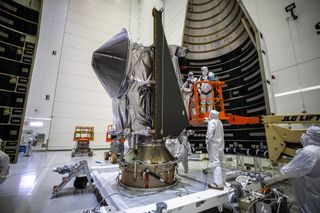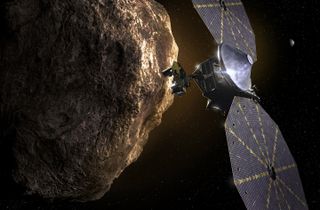NASA's asteroid spacecraft Lucy launches this week on ambitious 12-year mission

NASA's next asteroid-bound mission to explore the earliest days of our solar system is nearly ready to launch.
The Lucy spacecraft is targeting a launch window that opens on Saturday (Oct. 16). After blastoff, the spacecraft will make a 12-year journey to the outer solar system, where it will visit half a dozen ancient "Trojan" asteroids that orbit in the same path as the planet Jupiter.
This ambitious mission will include a number of firsts — Lucy will be the first spacecraft to visit asteroids in this region and the first to make a flyby of Earth from the outer solar system. Moreover, the mission will add fresh data as scientists seek to learn more about our universe's early history.
"No other space mission in history has been launched to as many different destinations in independent orbits around our sun," NASA said in a mission description. "Lucy will show us, for the first time, the diversity of the primordial bodies that built the planets."
Related: Lucy mission to explore 7 trojan asteroids explained by NASA
Lucy is named after a famous early australopithecine (humanoid) skeleton that is roughly 3.2 million years old, the discovery of which has long been hailed as a keystone in understanding human evolution. The skeleton itself was named after the Lucy in the 1967 Beatles tune, "Lucy in the Sky With Diamonds," a song to which excavators danced during the 1974 expedition that uncovered the skeleton, NASA said in a 2017 press release about the Lucy mission.
NASA drew inspiration from the Lucy skeleton, which to the agency represents the beginning of humans, in naming a mission that aims to teach us more about the beginnings of our solar system.
Get the Space.com Newsletter
Breaking space news, the latest updates on rocket launches, skywatching events and more!
"These asteroids really are like diamonds in the sky in terms of their scientific value for understanding how the giant planets formed and the solar system evolved," Harold Levison, principal investigator of Lucy at the Southwest Research Institute (SwRI), said in a 2017 NASA statement. Levison was the one who suggested naming the mission after the skeleton.
Lucy's dozen-year journey will take it to at least eight different asteroids, with three revisits to Earth (two before heading to the outer solar system, and one after) to pick up speed through gravity assists. One small world will be located in the "main belt" of asteroids between Mars and Jupiter, while the other seven are Trojans. Notably, four of the seven Trojans are paired up, allowing Lucy to view two asteroids simultaneously with each of those particular visits.
The mission will target a range of different kinds of asteroid bodies: C-type (chondrite, common ancient asteroids made of clay and silicate), D-type (asteroids with low albedos or reflectivity, which may be rich in organic molecules) and P-type (more asteroids with low albedos that may also be rich in organics, although we have no samples yet on Earth to confirm this).

In order, Lucy's planned asteroid targets are 52246 Donaldjohanson, 3547 Eurybates and its small satellite Queta, 15094 Polymele, 11351 Leucus, 21900 Orus and the binary 617 Patroclus/Menoetius. Lucy's website has more details about each asteroid's type, size and orbit.
"The dark-red P- and D-type Trojans resemble those found in the Kuiper Belt of icy bodies that extends beyond the orbit of Neptune," NASA officials wrote in the mission description. "The C-types are found mostly in the outer parts of the main belt of asteroids, between Mars and Jupiter. All of the Trojans are thought to be abundant in dark carbon compounds. Below an insulating blanket of dust, they are probably rich in water and other volatile substances."
Flying on Lucy will be several instruments: a color visible imager to determine composition; a long-range reconnaissance imager to pick up high-resolution images of each asteroid's surface; a thermal emission spectrometer to examine how the Trojans retain heat; a terminal-tracking camera to obtain wide-field images of the asteroids to learn more about their shapes; and a high-gain antenna to determine the masses of each of these small worlds.
Asteroids and comets represent the leftover small objects from when our solar system formed, roughly 4.5 billion years ago. Studying the makeup, orbits and other dynamics of these little worlds tell cosmologists more about how our neighborhood came to be.
Lucy will also build on numerous recent missions concerning asteroids, including NASA's OSIRIS-REx mission that is currently headed for Earth with a sample from asteroid Bennu and Japan's Hayabusa2 that returned to Earth in late 2020 with dust from asteroid Ryugu. Both of those objects are near-Earth asteroids, and comparing this category of space rock with Lucy's observations of the Trojans may give scientists a new path to understanding the solar system.
Follow Elizabeth Howell on Twitter @howellspace. Follow us on Twitter @Spacedotcom and on Facebook.
Join our Space Forums to keep talking space on the latest missions, night sky and more! And if you have a news tip, correction or comment, let us know at: community@space.com.

Elizabeth Howell (she/her), Ph.D., was a staff writer in the spaceflight channel between 2022 and 2024 specializing in Canadian space news. She was contributing writer for Space.com for 10 years from 2012 to 2024. Elizabeth's reporting includes multiple exclusives with the White House, speaking several times with the International Space Station, witnessing five human spaceflight launches on two continents, flying parabolic, working inside a spacesuit, and participating in a simulated Mars mission. Her latest book, "Why Am I Taller?" (ECW Press, 2022) is co-written with astronaut Dave Williams.